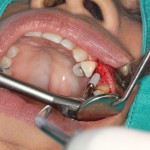
Non-surgical root canal treatment (NSRCT) is commonly carried out in order to retain the tooth. While success rates for NSRCT are good they are not always successful. If this is the case the potential options are; repeat NSRCT, endodontic microsurgery (EMS) or extraction and replacement with a single implant.
The aim of this review was to compare the outcomes of endodontic microsurgery (EMS) with extraction and placement of single implants (SIs).
Methods
Searches were conducted in PubMed, the Cochrane Library, Web of Science, and Embase databases. This was supplemented by hand searches of the Journals of Clinical Implant Dentistry and Related Research, Clinical Oral Implants Research, International Endodontic Journal, International Journal of Oral and Maxillofacial Implants, International Journal of Periodontics and Restorative Dentistry, International Journal of Prosthodontics, Journal of Endodontics, Journal of Periodontics, and Quintessence International.
Comparative or non-comparative; prospective or retrospective; longitudinal data related to clinical, biological, psychosocial and/or economic outcomes; and benefits and effects of saving teeth by EMS (regardless of root-end filling material type) or extraction and replacement with a single cylindrical dental implant (regardless of surface type) were considered. A minimum follow up period was 2-years was required.
Results
- No studies directly compared EMS and SI
- 44 studies of SI and 6 studies of EMS were included.
- Of the 44 SI studies 54% had prospective cohort designs; only 6% were clinical trials with randomization.
- SI survival rates varied from 96% (95% CI, 93-98%) at 2–4 years to 98% (CI, 95-99%) for 6+ years
- Of the 6 EMS studies 3 were randomised controlled trials, 1 case-control and 2 prospective cohorts.
- EMS had survival rates of 94% (95%CI, 91-97%) at 2–4 years and 88% (95% CI, 84-92%) at 4–6 years
- Qualitatively different success criteria precluded valid comparison of success rates.
- Only 5 of the SI studies and one of the EMD studies addressed psychosocial outcomes
- None of the included studies addressed economic outcomes.
Conclusions
The authors concluded:
The quality of the articles reporting on single implants and endodontic microsurgery was only moderate. Data on single implant out- comes was much more plentiful than those on endodontic microsurgery, but the endodontic microsurgery studies had a slightly higher overall quality rating. At 4–6 years, single implants had higher survival rates than teeth treated with endodontic microsurgery. Qualitatively different success criteria precluded valid comparison of success rates between treatments.
Commentary
A wide range of databases were searched for this review although only English language studies were included. It would appear that all the authors were involved with study selection. A points system was used to assess study quality however points systems are not ideal as some elements of study design are more important for the reduction of bias than others. Only 60 % of the SI studies were prospective designs but all of them appear to have contributed to the meta-analysis. It would have been interesting to have restricted the met-analysis to just the prospective studies as the other studies designs which are unfortunately not described are likely to have bern more prone to bias.
The authors highlight challenges with many of the studies in relation to the success criteria applied both for the SI and EMS studies. They also point to a contrast in assessment of complications between the SI and EMS groups. As they note this makes proper comparisons between these two alternative treatment approaches difficult. The authors rank the overall evidence for SI and EMS moderate but given the issues highlighted in the text it is possible that this could be seen as being generous. What is clear is the quality of studies in this area needs to be improved and there needs to some agree core outcomes that can be reported for studies of SIs and EMS to improve the ability to compare these options fairly.
Links
Torabinejad M, Landaez M, Milan M, Sun CX, Henkin J, Al-Ardah A, Kattadiyil M, Bahjri K, Dehom S, Cortez E, White SN. Tooth Retention through Endodontic Microsurgery or Tooth Replacement Using Single Implants: A Systematic Review of Treatment Outcomes. J Endod. 2014 Oct 9. pii: S0099-2399(14)00824-3. doi: 10.1016/j.joen.2014.09.002. [Epub ahead of print] Review. PubMed PMID: 25306305.

[…] Dental Elf – 15th Oct 2014 – Endodontic microsurgery or single tooth implants after fail… […]
[…] Endodontic microsurgery or single tooth implants after failed root canal treatment […]